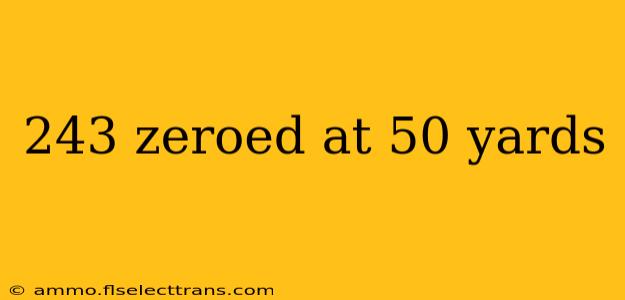243 Zeroed at 50 Yards: Understanding Your Rifle's Performance
Zeroing a rifle is a crucial step for any shooter, ensuring accuracy and consistent bullet placement at various ranges. Zeroing your .243 Winchester at 50 yards offers a solid foundation, but understanding the implications and limitations of this choice is vital. This post will delve into the specifics of a 50-yard zero, its advantages, disadvantages, and how it affects your shooting at longer distances.
Why Choose a 50-Yard Zero?
A 50-yard zero is a popular starting point for many .243 Winchester owners, primarily because:
- Easier to achieve: At closer ranges, minor adjustments have less impact on point of impact (POI), making it simpler to dial in your rifle's zero. This is especially beneficial for new shooters or those unfamiliar with their specific rifle and ammunition.
- Suitable for close-range hunting: If your primary hunting scenarios involve shots within 100-150 yards, a 50-yard zero provides acceptable accuracy without significant adjustments needed. Many varmint hunters find this a practical solution.
- Reduced bullet drop at medium ranges: While not ideal for long-range shooting, a 50-yard zero does mitigate bullet drop at medium ranges compared to a longer zero distance.
Disadvantages of a 50-Yard Zero
While convenient, a 50-yard zero has limitations that should be considered:
- Significant bullet drop beyond 100 yards: The bullet's trajectory will drop more drastically after 100 yards, requiring significant adjustments for accurate shots at longer distances. This makes it less suitable for long-range hunting or target shooting.
- Potential for overshooting at shorter ranges: Depending on your rifle's characteristics and the ammunition used, you may slightly overshoot at ranges shorter than 50 yards. This needs to be accounted for in practical shooting situations.
- Less forgiving for errors: The closer the zero distance, the more sensitive the rifle becomes to variations in environmental factors like wind and atmospheric conditions. A small error can lead to a larger deviation in POI.
Understanding Bullet Trajectory and the Importance of Ballistics
Bullet trajectory is not a straight line; it's a parabola shaped curve influenced by gravity, air resistance, and other external forces. Zeroing your rifle at 50 yards means that the bullet will impact at the same point as your point of aim at 50 yards, but the bullet will travel above your point of aim before falling back to it at a more distant point. This is why understanding your specific ammunition's ballistic coefficients is crucial for making accurate long-range shots.
Beyond 50 Yards: Making Adjustments
If you intend to shoot beyond 100 yards, you'll need to know your rifle's trajectory with the ammunition you're using. This can be determined through range testing or by utilizing online ballistic calculators that factor in environmental variables. Most shooters will opt for a longer zero distance (like 100 or 200 yards), offering a flatter trajectory at medium ranges and more predictable bullet drop at longer distances.
Conclusion: Is a 50-Yard Zero Right for You?
A 50-yard zero for your .243 Winchester is a viable option if your shooting predominantly occurs within 100-150 yards. However, understanding its limitations, especially concerning longer-range shooting, is crucial. If you anticipate regularly shooting beyond 150 yards, consider a longer zero distance for optimal accuracy. Accurate shooting requires practice and a thorough understanding of your rifle, ammunition, and the principles of ballistics.

